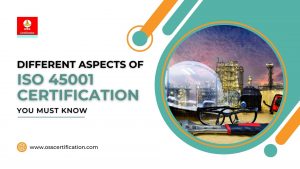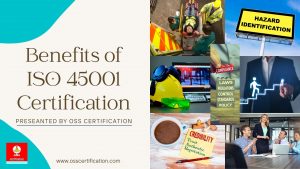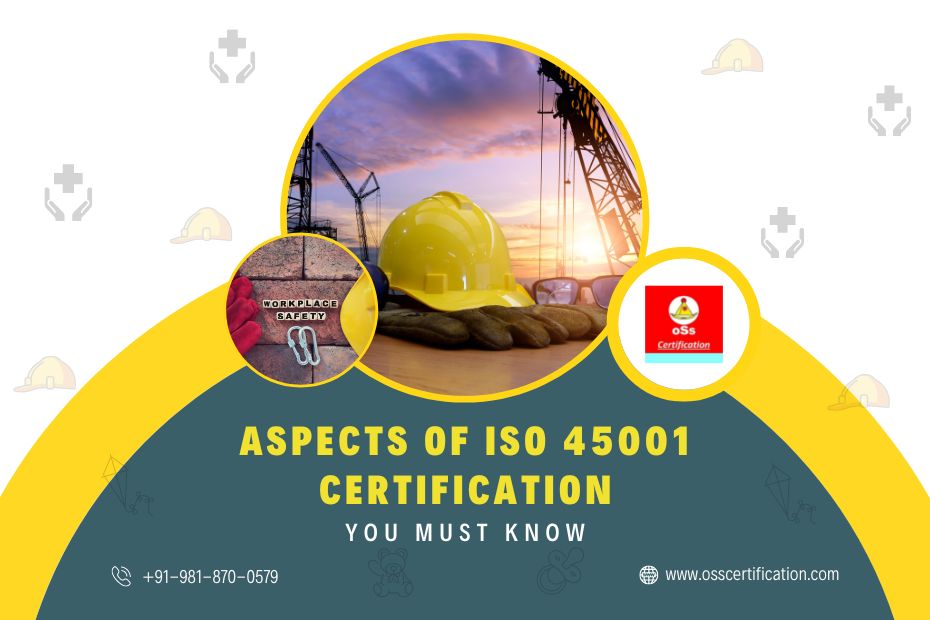ISO 45001 Certification is an Occupational Health and Safety Management System Certification. Also known as OHSMS Certification or OH&S certification. Nowadays it has become the most common requirement for ISO 45001 Certification for the organization, to assure a safe working place for workers. As per the guidelines of the International Labour Organization, it is the responsibility of the organization to ensure that all work-related safety control measures are in place. So that in routine work activities, OHS risks can be reduced and prevent any accidents, incidents, and ill health to workers and Interested parties.
So, when the organization planning for ISO 45001 Certification from an accredited ISO Certification Body (i.e OSS Certification), the Different Aspects of ISO 45001 Certification Must Know, before taking any decision for adopting ISO 45001 Standard for implementation in the organization.
As a business organization, it is a very basic question, what is ISO 45001 certification, and why it is important, what are its benefits, when the organization adopts ISO 45001 standard for implementation? So, in this blog, we will explain this basic question along with explaining the different aspects of ISO 45001 Certification the organization must know.
Before moving ahead, let’s understand ISO 45001 – Occupational Health and Safety Management System (OHSMS) Standard.
Let’s Understand ISO 45001 First!
ISO 45001 is an Occupational Health and Safety Management System, also known as OH&S Management System. This Standard was published in the year 2018, after the replacement of OHSHS 18001. The requirements of assurance of the Health & Safety of workers become a necessity for the organization. The way long back, when the International Labour Organization (ILO) and Govt. has set responsibility, that organization is responsible for the occupational health and safety of workers and others who can be affected by its activities.
In case of any events -such as Fatal, accidents, incidents, or any mental health issues that occurred while working in the organization. it will be considered as a lapse of the organization for taking care of workers’ Health & Safety while working in the organization or any interested party who is affected. Considering Occupational Health & Safety a common framework was developed a year back as the OHSAS 18001 standard for Occupational Health & Safety and for success, acceptability, and outcome of this OHSAS 18001 standard, the international organization of Standardization (ISO) has taken the initiative for the development of ISO Standard on Occupational health and safety by taking inputs from Industry experts and ILO guideline. This ISO 45001 standard was published in 2018, for use by the organization for Implementation and ISO 45001 Certification.
Occupational health and safety Management System Standard – ISO 45001 – provides the requirements for managing the OH&S Risk in the organization. Hazard identification, analysis, and apply the necessary control measures. To prevent work-related injury and ill health to workers and provide safe and healthy workplaces. This standard can be adopted for implementation by any organization irrespective of the size, type, and nature of activities.
But it is recommended for OHS implementation and ISO 45001 Certification to those organizations, where there is huge potential for a work-related injury, accident, mental health issue, etc – such as Construction, infrastructure development companies, involved in Oil & Gas, Logistic & Transport, Manufacturing organization, etc so on. But it is not limited to any organization that can adopt this standard for Implementations and ISO certification from an accredited ISO 45001 Certification Body (i.e OSS Certification).

The Key Aspects of ISO 45001 Certification
When the organization planning for ISO 45001 Certification, the following key aspects of ISO 45001- Occupational Health and Safety management are to be considered.
- Awareness and Training to all the employees of the organization about Occupational Health and Safety.
- Training on ISO 45001 requirements to at least the key process owners.
- Awareness about OHS policy and Objectives for all workers and Interested parties.
- Knowledge about applicable OHS regulations and other requirements related to Occupational Health and Safety.
- Knowledge about OHS hazards in the organization.
- OHS Hazard Identification and It Risk Analysis and taking corrective measures to prevent any accidents & Incidents.
- Worker Participation in all OHS-related activities – such as OHS policy & objective Development, OHS hazard Identification, implementation of Safety control measures, and OHS Legal requirement.
- Timely worker’s health Check-up.
- Ensuring availability of First-Aid and panel doctor for routine health check-ups of workers and attending in case of any emergency.
- Availability of Emergency preparedness.
- Timely monitoring of the OHS performance of the organization.
- Keep updated on the Legal register.
- Development and Implementation of necessary SOP
- Timely Conducting of Internal Audit and Management Review meetings.
These are the key aspects of ISO 45001 Certification, at least the organization shall maintain, at least in the organization. In addition to these aspects, there are several other requirements to be considered. The organization looks into the ISO 45001 Standard.
Benefits of ISO 45001 Certification
When the organization implements OHS Standard, the following most prominent benefits the organization may experience, Such as
- OHS Hazard Identification and OHS Risk Management
- Possibility to reduce the accident, incidents & ill health
- Overall productivity improved (as workers are working without fear of accident)
- Moral Boosting of workers on safety point of view
- The credibility of the organization enhanced
- OHS legal Compliances improved
- Health & Safety Awareness among workers improved

Also read- What are the benefits of ISO 45001?
How to get ISO 45001 Certification
The organization looking to get ISO 45001 Certification, is advised to implement the requirements of ISO 45001. Develop and implement the necessary document & records. Apply to a Certification Body, and get a proposal to know the cost of ISO 45001 Certification.
While the Certification process, the Certification Body follows the Following steps
- Application review and Audit Team assignment for on-site Audit
- Onsite Audit by Auditors of Certification Body.
- Audit report review and Certification Decision.
- Award of Certificate
The Validity of the ISO 45001 Certificate is for 3 years from the date of issue of the Certificate, Subject to the organization maintaining the compliance during annual surveillance Audit.
This is all about the Aspects of ISO 45001 Certification that shall be considered by the organization for Certification.
Most recommended ISO Standard along with ISO 45001 Certification
As per Industry practices, the organization is looking for Integrated Management System Certification in the combination of ISO 45001 along with another ISO Standard. Taking an opportunity to further explain, the ISO Standard, which is most commonly recommended by Industry experts for Certification along with ISO 45001.
When the organization is planning for Integrated Management System Implementation and further IMS Certification. As per industry experts’ views, ISO 9001 Certification and ISO 14001 Certification are most recommended for IMS certification along with ISO 45001. There are several benefits to IMS certification. The benefits of Integrated Management System (IMS) implementation and Certification are given below.
Taking an Example – When Choosing ISO 45001, ISO 14001 & ISO 9001 Certification together for implementation.
- Most of the requirements are similar, except for some EMS & OHS-specific requirements. So common integrated documents, SOP, and records are required for implementation.
- Internal Audit, Management Review meetings, Policy, and Training can be integrated covering the requirements of QMS, EMS & OHSMS
- Common Resources can be assigned to IMS
- Time of Implementation reduced
- Better Documents Control
- Cost of Certification Reduced
So, when the organization is planning for IMS certification – ISO 45001, ISO 14001 & ISO 9001 Certification, it is most recommended by industry experts.
